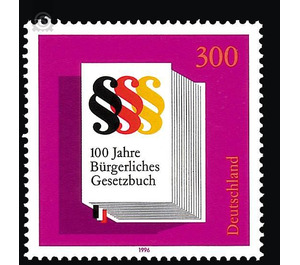100 years Civil Code - Germany / Federal Republic of Germany 1996 - 300 Pfennig
Theme: Art & Culture
| Country | Germany / Federal Republic of Germany |
| Issue Date | 1996 |
| Face Value | 300.00 |
| Color | violet |
| Perforation | K 13 3/4 |
| Printing Type | Multicolor offset printing |
| Stamp Type | Postage stamp |
| Item Type | Stamp |
| Chronological Issue Number | 1747 |
| Chronological Chapter | GER-BRD |
| SID | 835893 |
| In 43 Wishlists | |
The most important legal source of German civil law is the Civil Code. The Civil Code came into force after completion on 18 August 1896 and proclamation on 24 August 1896 on 1 January 1900 for the entire then German Reich. Frequently amended, it is now in the Federal Republic of Germany as federal law. The Civil Code has 2,385 paragraphs and is divided into five books. Systematically follows the division of the pandectic, that is, it was a classification of the private law substance by persons, property and rights made. It is further characterized by a highly abstract terminology, which takes into account the desire to be able to regulate as much as possible any life circumstances. At the same time, however, this endeavor has also meant that the Civil Code is hardly comprehensible to the layman. The BGB has had the opportunity to interpret laws and gaps have the opportunity to shift its emphasis on the social conditions of the liberalism of the then dominant bourgeoisie towards a stronger social bond. At the same time, however, the design options have also made it possible to misuse the Nazi state. From October 3, 1990, the Civil Code is again governed by the Unification Treaty for the United Germany, after it had been replaced in the GDR since 1 January 1976 by the Civil Code (ZGB). Overall, during the 100 years of existence, a stability and permanence can be seen, which is still valid today and gives an indication of the timelessness of this work. (Text: Annette Melcher, University of Bonn)


